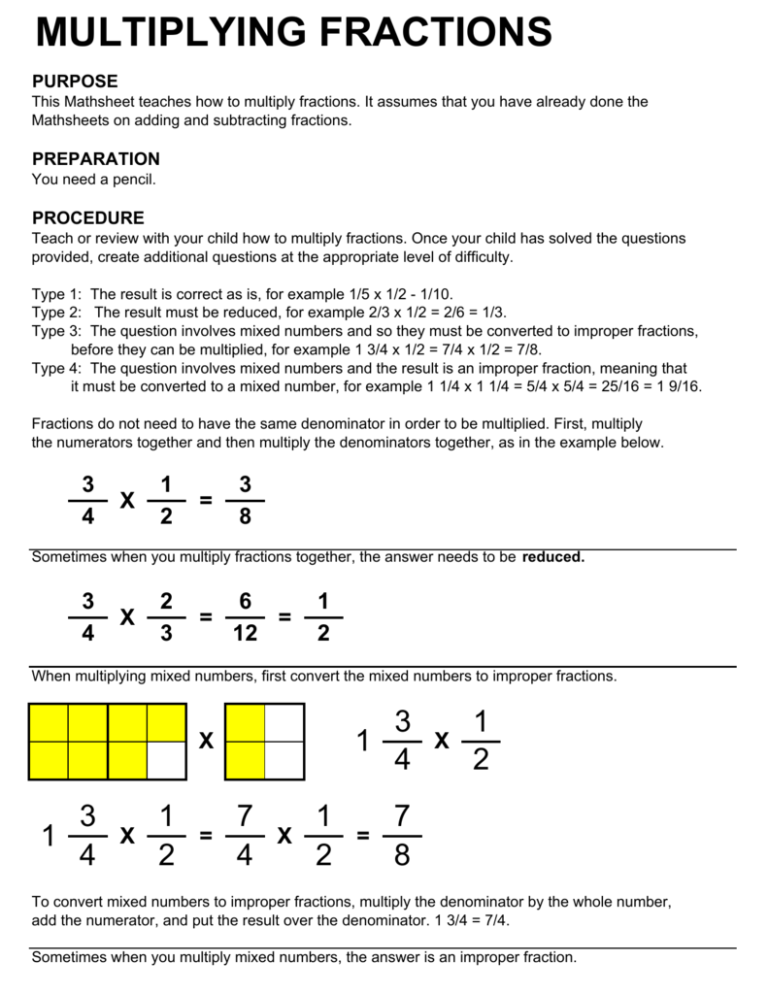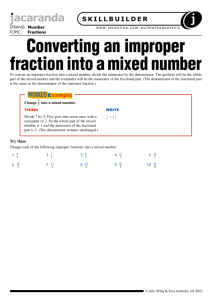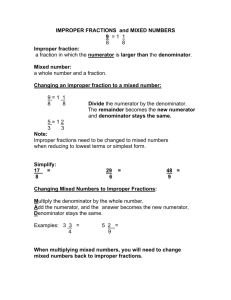multiplying fractions - Society for Quality Education
advertisement

MULTIPLYING FRACTIONS PURPOSE This Mathsheet teaches how to multiply fractions. It assumes that you have already done the Mathsheets on adding and subtracting fractions. PREPARATION You need a pencil. PROCEDURE Teach or review with your child how to multiply fractions. Once your child has solved the questions provided, create additional questions at the appropriate level of difficulty. Type 1: The result is correct as is, for example 1/5 x 1/2 - 1/10. Type 2: The result must be reduced, for example 2/3 x 1/2 = 2/6 = 1/3. Type 3: The question involves mixed numbers and so they must be converted to improper fractions, before they can be multiplied, for example 1 3/4 x 1/2 = 7/4 x 1/2 = 7/8. Type 4: The question involves mixed numbers and the result is an improper fraction, meaning that it must be converted to a mixed number, for example 1 1/4 x 1 1/4 = 5/4 x 5/4 = 25/16 = 1 9/16. Fractions do not need to have the same denominator in order to be multiplied. First, multiply the numerators together and then multiply the denominators together, as in the example below. 3 4 X 1 2 = 3 8 Sometimes when you multiply fractions together, the answer needs to be reduced. 3 4 X 2 3 = 6 = 12 1 2 When multiplying mixed numbers, first convert the mixed numbers to improper fractions. 3 1 4 X 3 1 4 X 1 2 = 7 4 X 1 2 = X 1 2 7 8 To convert mixed numbers to improper fractions, multiply the denominator by the whole number, add the numerator, and put the result over the denominator. 1 3/4 = 7/4. Sometimes when you multiply mixed numbers, the answer is an improper fraction. X 1 1 4 = 5 4 3 1 4 = 5 4 1 1 4 X 5 4 5 4 X 1 1 4 = 25 16 = 1 9 16 You convert improper fractions by dividing the numerator by the denominator. The number of times the numerator will go into the denominator becomes the whole number portion of the mixed number, the remainder becomes the numerator of the fraction portion of the mixed number, and the denominator remains the same. In the above example, 16 goes into 25 once, and the remainder (9) is the numerator. Type 1 3 4 X 1 2 = X 2 3 = 3 4 X 1 2 1 4 X 2 5 = 1 4 X 1 1 4 = X = = 3 4 X 1 1 4 = X = = 2 3 X 2 1 4 = X = = Type 2 3 4 = Type 3 1 = X 1 2 = X 2 5 = Type 3 1 = Type 4 1 Type 4 1 Type 4 1 =






